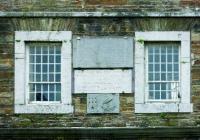Clock Gate, Youghal, Co. Cork
Published in Early Modern History (1500–1700), Features, Issue 6 (Nov/Dec 2010), Volume 18![Youghal’s Clock Gate today. In May 1777 an engraver was employed ‘to prepare two marble stones [inset] for the Clock Castle, with the Corporation arms and the magistrates’ names engraved on them’. (NIAH)](https://www.historyireland.com/wp-content/uploads/2013/03/82_small_1290180806.jpg)
Youghal’s Clock Gate today. In May 1777 an engraver was employed ‘to prepare two marble stones [inset] for the Clock Castle, with the Corporation arms and the magistrates’ names engraved on them’. (NIAH)
In 1622 Balltazar Portingale was appointed as clock-keeper and was given free quarters in return for ringing the clock ‘at four in the morning from Easter to Mich[aelmas], and at five in the morning from Mich[aelmas] to Easter, and at nine at night all the year’.
In spite of intermittent repairs to the building, Trinity Gate inevitably began to deteriorate. On 20 October 1776 a decision was made to demolish the building and replace it with ‘a gaol and gaoler’s house, with a proper building for a clock and bell, the gaoler’s house to consist of two rooms as the ground will allow, and over the gaoler’s house two gaols or marshalseas, and over them a bell room, with a spire and cupola and decorations’. Three weeks later, the Corporation declared ‘That as soon as the weather will permit the Clock Castle be pulled down, and a building erected in its room, according to a plan given this day by Mr Will. Mead’. Strict orders were given ‘that no Corporation money be granted until the completion of the building’. William Dyke was paid £12 for dismantling the old gate, and a team of masons was employed at 2s 8?d per day for the construction of the new building. In May 1777 an engraver was employed ‘to prepare two marble stones for the Clock Castle, with the Corporation arms and the magistrates’ names engraved on them’.
 The imposing height and austere style of the Clock Gate reflect its function as a prison. In 1795 the building was enlarged by the addition of a new storey to facilitate the rising number of people arrested as rebels. Several members of the United Irishmen were publicly hanged from the Clock Gate windows, including the patriots Charles O’Brien and Charles Gallagher. The building became a symbol of terror and tyranny, a reputation it was to hold until 1837, when it ceased to serve as gaol and public gallows. The Clock Gate has not been in public use since housing a museum in the 1970s, but remains one of the most captivating and distinctive landmarks in Youghal. HI
The imposing height and austere style of the Clock Gate reflect its function as a prison. In 1795 the building was enlarged by the addition of a new storey to facilitate the rising number of people arrested as rebels. Several members of the United Irishmen were publicly hanged from the Clock Gate windows, including the patriots Charles O’Brien and Charles Gallagher. The building became a symbol of terror and tyranny, a reputation it was to hold until 1837, when it ceased to serve as gaol and public gallows. The Clock Gate has not been in public use since housing a museum in the 1970s, but remains one of the most captivating and distinctive landmarks in Youghal. HI
Anna-Maria Hajba is an architectural historian. Series based on the NIAH’s ‘building of the month’, www.buildingsofireland.com.
















